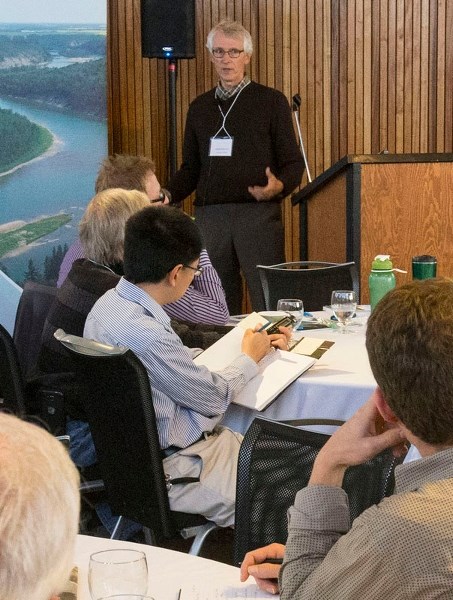By Kevin Ma
New research from a renowned water scientist suggests that the Sturgeon watershed has just been through one of its driest periods in more than a century.
David Sauchyn, a hydrologist with the Prairie Adaptation Research Collaborative at the University of Regina, spoke on future water trends in Alberta and the Sturgeon last Sept. 17 at the Enjoy Centre.
His talk was part of a free public forum on the Sturgeon watershed organized by the North Saskatchewan Watershed Alliance (NSWA).
As there were big gaps in the flow records for the Sturgeon, Sauchyn said he recently took and analyzed a core sample from a tree in the Grey Nuns White Spruce park to try and gauge how water levels in the region have changed over time.
The result was a rough record of wet and dry years in the watershed dating back to 1868 – likely the most complete record of moisture levels in the Sturgeon ever compiled.
"According to the trees, we've just been through the driest period of the last 150 years at St. Albert," he said, presenting a chart of the tree ring data.
While that data also suggests that flow rates in the Sturgeon have been on the decline for the last 10 to 20 years, Sauchyn cautioned in an interview that the extreme natural variability of our prairie climate makes it almost impossible to pick out any long-term trend.
But climate models suggest that we should expect our precipitation to move away from the summer and towards the winter due to climate change, which means we'll be getting less water in the summer.
"By the time you get to summer and mid- to late-summer, you're going to be pretty low."
Alberta Agriculture soil moisture technician Ralph Wright also spoke at the forum, and said his research suggests the Sturgeon had its driest growing season since records began in 1961 this year. The St. Albert monitoring station had recorded just 67 millimetres of moisture since the start of the season as of July 10, whereas it would normally have had 190.
"That's more than an entire month of rainfall," he said.
River under pressure
Thursday's talk was meant to inform local leaders about the state of the Sturgeon, said David Trew, executive director of the NSWA.
"We've got well over 150,000 people living in the Sturgeon watershed now," he said, with many more expected in the future. This could place high demand on the river for water.
"The potential for conflict is very high."
A water supply and demand study done last year by the NSWA on the Sturgeon near where it meets the North Saskatchewan found that the river was likely below the instream flow needs threshold (the amount of flow needed to sustain natural ecosystems) 35 per cent of the time, Trew said.
"We've only done a very, very coarse scale look at it," he cautioned, and they've yet to determine if these low flows are due to human withdrawals from the river.
The Sturgeon has seen massive changes in its land use over the last few decades, said presenter Jay White, who has done extensive research on the watershed with Aquality Environmental Consulting.
"In one of the sub-basins I worked in, we lost 50 per cent of our trees in a 10-year period."
The overall state of the watershed was "fair," with pollutants such as nitrogen, phosphorous and E. coli all trending up, White continued.
"Unless we've done an awful lot of work in the watershed on improving riparian areas and wetlands, there's no way in hell that things will be getting better."
White and Sauchyn said governments should do more to protect riparian zones to maintain the Sturgeon's health in the future.
"Those are nature's kidneys," White said.
Healthy watersheds will be better poised to handle the effects of climate change, Sauchyn said.
"If you manage the watershed so it can take the shock, then the people of the watershed will be better off."




